CHRONOLOGY OF THE SQUAREGATE, Continued
In 1579, publication by FRançois Viéte (1540-1603) , Canon mathematica.
, Canon mathematica.
In 1474 appeared the Ephemerides astronomicae of Regiomantanus -- born Johan Müller (?-1496). Later editions included tables of solar declination, of great use to navigators.
1492, the Spanish conquer the Moorish Kingdom of Grenada, consolidating the monarchy of Ferdinand of Aragon and Isabella of Castile. The fall of the city of Toledo in Grenada opened up Islamic science and mathematics to Europe.
In 1504, Christopher Columbus used an edition of Regiomantanus' Ephemerides to predict a total eclipse of the moon on Feb. 29. This so frightened Native Americans that they allowed Columbus and his crew to escape.
In 1614, John Napier (1550-1617)  published table of logarithms of sine, cosine, and tangents (not numbers!), for navigational calculations.
published table of logarithms of sine, cosine, and tangents (not numbers!), for navigational calculations.
(French) Pierre de Fermat (1601-65)  developed a method for calculating maxima and minima of functions or curves, anticipating the "calculus", later developed by Newton and Leibnitz. (This was to "solve THE SQUAREGATE PUZZLE".)
developed a method for calculating maxima and minima of functions or curves, anticipating the "calculus", later developed by Newton and Leibnitz. (This was to "solve THE SQUAREGATE PUZZLE".)
 Bonaventura Cavalieri (1598-1647) was an Italian
mathematician and student of Galileo. In 1635, in his Geometria indivisibilibis, he stated "Cavalieri's Principle": if two solids have the same height, and if their cross
sections taken parallel to and at equal distances from their bases are always equal, then the
solids have the same volume. This was a stepping stone towards calculus.
Bonaventura Cavalieri (1598-1647) was an Italian
mathematician and student of Galileo. In 1635, in his Geometria indivisibilibis, he stated "Cavalieri's Principle": if two solids have the same height, and if their cross
sections taken parallel to and at equal distances from their bases are always equal, then the
solids have the same volume. This was a stepping stone towards calculus.
Arithmetica infinitorum (1655), by (English) John Wallis (1616-1703), treats infinite series arithmetically, a step toward integral calculus.
In 1668, (Flemish) Gerardus Mercator (a.k.a Gerard Kremer)(1612-1594)
 , published
Logarithmotechnia, with the famous "Mercator" projection still used on maps today -- a great boon to navigation.
, published
Logarithmotechnia, with the famous "Mercator" projection still used on maps today -- a great boon to navigation.
 In 1670, (English) Isaac Barrow (1630-1677), published Lectiones geometria, with theorems about drawing tangents to curves, calculating lengths of curves and areas under curves. As Newton's teacher, Barrow gave Newton the tangential clue to the differential calculus and the area under a curve clue to the integral calculus.
In 1670, (English) Isaac Barrow (1630-1677), published Lectiones geometria, with theorems about drawing tangents to curves, calculating lengths of curves and areas under curves. As Newton's teacher, Barrow gave Newton the tangential clue to the differential calculus and the area under a curve clue to the integral calculus.
Sent home on leave in 1671 when Cambridge University was closed by a plague, Isaac Newton (1643-1712) used Barrow's clues to develop his form of calculus, known as "fluxions".
(1643-1712) used Barrow's clues to develop his form of calculus, known as "fluxions".
In 1675, (German) Gotthold Wilhelm Leibniz (1646-1716)  developed the modern notation for calulus, which Leibinitz developed independently of Newton. In 1684 appeared Leibnitz's first paper on calculus.
developed the modern notation for calulus, which Leibinitz developed independently of Newton. In 1684 appeared Leibnitz's first paper on calculus.
1687, Newton's Principia mathematica presented a mathematical treatment of the Solar System, showing that an inverse square gravity law UNITES phenomenon in "heaven" and on earth. These results were obtained by calculus, but (to avoid attack by contemporaries) demonstrated geometrically. In particular, "Newton's Laws of Physics" were effectively
developed only for translation (straight-forward motion); development in terms of rotation was only achieved after Newton's death by Euler -- something most textbooks and teacher fail to note.
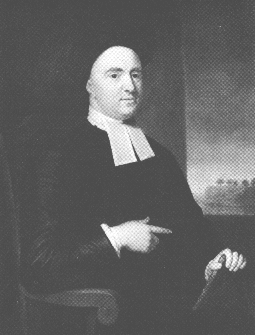 In 1734, (Irish) George Berkeley, (1685-1743), Bishop of Cloyne, wrote a memoir, The Analyst, attacking Newton's version of "the calculus" (known as "fluxions"). Mathematical historian, Florian Cajori, has called publication of this memoir "the most spectacular event of that century in the history of mathematics". For this devastating criticism provoked "the Second Crisis in The Foundations of Mathematics". (Its eventual resolution in the 19th century, gave firm support to "the calculus", bringing about our present Civilization.) In 1728, Berkeley came to America and spent 3 years in Rhode Island. Later, back in Ireland, Berkeley wrote a poem, "On the Prospect of Planting Arts and Learning in America", whose last stanza begins with a line often quoted by orators and politicians:
In 1734, (Irish) George Berkeley, (1685-1743), Bishop of Cloyne, wrote a memoir, The Analyst, attacking Newton's version of "the calculus" (known as "fluxions"). Mathematical historian, Florian Cajori, has called publication of this memoir "the most spectacular event of that century in the history of mathematics". For this devastating criticism provoked "the Second Crisis in The Foundations of Mathematics". (Its eventual resolution in the 19th century, gave firm support to "the calculus", bringing about our present Civilization.) In 1728, Berkeley came to America and spent 3 years in Rhode Island. Later, back in Ireland, Berkeley wrote a poem, "On the Prospect of Planting Arts and Learning in America", whose last stanza begins with a line often quoted by orators and politicians:
Westward the course of empire takes its way;
The first four acts already past,
A fifth shall close the drama with the day;
Time's noblest offspring is the last.
Because of this work, the town of Berkeley, California, was named after this man, as well as
The University of California at Berkeley.
In 1736, (Swiss) Leonhard Euler (1707-1783)
 published his Mechanica, sive motus scientia analytice, formulating "Newton's Laws" in rotational terms and showing the power of The Laws of Linear and Curvilinear Momentum.
published his Mechanica, sive motus scientia analytice, formulating "Newton's Laws" in rotational terms and showing the power of The Laws of Linear and Curvilinear Momentum.
 In 1776, (English) James Watt installed two of his steam engines, initially used in mining. This same year, John Wilkinson used a steam engine to activate an efficient blast furnace for iron-making. By the end of the century, there were 24 blast furnaces in England. The Thermodynamic Industrial Revolution
had begun. By 1807, American inventor, Robert Fulton (1765=1815), had built a successful
steamship, The Clermont. Steamships eventually ended need for galley-slaves, chained to oarlocks, to
propel warships and other large ships.
In 1776, (English) James Watt installed two of his steam engines, initially used in mining. This same year, John Wilkinson used a steam engine to activate an efficient blast furnace for iron-making. By the end of the century, there were 24 blast furnaces in England. The Thermodynamic Industrial Revolution
had begun. By 1807, American inventor, Robert Fulton (1765=1815), had built a successful
steamship, The Clermont. Steamships eventually ended need for galley-slaves, chained to oarlocks, to
propel warships and other large ships.
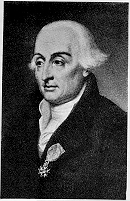 In 1788, (French) Joseph Louis Lagrange (1736-1813) published his Mechanique analytique, which used work of Euler and the calculus of variations to present an alternative to Newton's laws of physics. From this point on, enough mathematics became available to "ripen" the Mechanical Industrial Revolution, to further The Thermodynamic Industrial Revolution and to prepare for The Electrical Industrial Revolution.
In 1788, (French) Joseph Louis Lagrange (1736-1813) published his Mechanique analytique, which used work of Euler and the calculus of variations to present an alternative to Newton's laws of physics. From this point on, enough mathematics became available to "ripen" the Mechanical Industrial Revolution, to further The Thermodynamic Industrial Revolution and to prepare for The Electrical Industrial Revolution.
(English) George Green (1793-1841) (apparently no picture exists) was a self-taught miller. His Essay on the mathematical analysis to the theories of electricity and magnetism introduced many powerful tools to pure mathematics and to applied mathematics. In particular, Greene created the concept of potential, from which a force can be derived. (And "Greene's Function" was used in the 1940's by (American) Richard Feynman (1918-1988) in developing an alternative to the quantum theory approaches of (German) Werner Heisenberg (1901-1976) and (Austrian) Erwin Schrödinger(1887-1961.)
1821 saw publication of Cours d'analyse de l'Ecole Polytechnique, by Augustin Marie Cauchy (1789-1857), putting "calculus" on a firm foundation, a major step in resolving "The Second Crisis in The Foundations of Mathematics". Cauchy defined irrational numbers such as √2 as an unending sequence of rational numbers, each as simple as "an Egyptian fraction".
(1789-1857), putting "calculus" on a firm foundation, a major step in resolving "The Second Crisis in The Foundations of Mathematics". Cauchy defined irrational numbers such as √2 as an unending sequence of rational numbers, each as simple as "an Egyptian fraction".
 (German) Karl Friedrich Gauss (1777-1855) is considered to be "the greatest of mathematicians". But in 1833, Gauss collaborated with physicist Wilhelm Weber to develop an improvement on Samuel Morse's electric telegraph. The applied mathematics Gauss developed for this, along with that of George Greene, prepared the way for the great work of Clerk-Maxwell and The Electrical Industrial Revolution.
(German) Karl Friedrich Gauss (1777-1855) is considered to be "the greatest of mathematicians". But in 1833, Gauss collaborated with physicist Wilhelm Weber to develop an improvement on Samuel Morse's electric telegraph. The applied mathematics Gauss developed for this, along with that of George Greene, prepared the way for the great work of Clerk-Maxwell and The Electrical Industrial Revolution.
In 1845, (English) Michael Faraday (1791-1867) 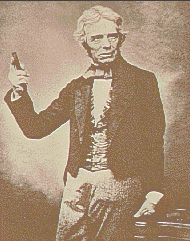 discovered diamagnetism and paramagnetism, and related light to magnetism by discovering that a magnetic field affects polarization of light in crystals. So Faraday proposef that light may be waves of electromagnetism.
discovered diamagnetism and paramagnetism, and related light to magnetism by discovering that a magnetic field affects polarization of light in crystals. So Faraday proposef that light may be waves of electromagnetism.
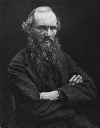 In 1855, (Scot) William Thomson (knighted as Lord Kelvin) developed a theory of transmission of electric signals through submarine cables, and later directed the laying of the Trans-Atlantic Cable System. A big advance towards The Electrical Industrial Revolution.
In 1855, (Scot) William Thomson (knighted as Lord Kelvin) developed a theory of transmission of electric signals through submarine cables, and later directed the laying of the Trans-Atlantic Cable System. A big advance towards The Electrical Industrial Revolution.
 In 1857, (German) physicist Gustav Rudolph Kirkhoff (1824-1887) discovered that statis electric forces and magnetic forces are related by a constant that turned out to be the speed of light in a vacuum, first indication of a relation between electromagnetics and optics. ("Kirkhoff's Laws" are used to day in electric circuit analysis.)
In 1857, (German) physicist Gustav Rudolph Kirkhoff (1824-1887) discovered that statis electric forces and magnetic forces are related by a constant that turned out to be the speed of light in a vacuum, first indication of a relation between electromagnetics and optics. ("Kirkhoff's Laws" are used to day in electric circuit analysis.)
 In 1860, (Scot) James Clerk Maxwell (1831-1879) -- independently of work by (German) Ludwig Boltzmann (1844-1906) -- developed study of the statistical properties of molecules in a gas -- a great advance in The Thermnodynamic Industrial Revolution. (Texts today speak of "Maxwell-Boltzmann" statistics. It was shifting from these to "Fermi-Dirac statistics" and "Einstein Bose statistics", which initiated one of the greatest advances in quantum theory.)
In 1860, (Scot) James Clerk Maxwell (1831-1879) -- independently of work by (German) Ludwig Boltzmann (1844-1906) -- developed study of the statistical properties of molecules in a gas -- a great advance in The Thermnodynamic Industrial Revolution. (Texts today speak of "Maxwell-Boltzmann" statistics. It was shifting from these to "Fermi-Dirac statistics" and "Einstein Bose statistics", which initiated one of the greatest advances in quantum theory.)
1861-1865, American Civil War (a.k.a. War Between The States), over issue of Slavery and States' Rights -- a war between two Industrial Revolutions: The Thermodynamic Industrial Revolution of "The North" and the Mechanical Industrial Revolution of "The South".
In 1863, President Abraham Lincoln (1809-1865) signed the Emancipation Act, formally ending slavery in the United States on Jan. 1, 1863.
Maxwell's 1864 paper, A dynamical theory of electromagnetism, formulates Faraday's field concept in mathematical equations.
In 1872, Karl Weierstrass (1815-97)  put "calculus" on its present firm "arithmetical" foundation.
put "calculus" on its present firm "arithmetical" foundation.
Maxwell's 1873 paper, contains the basic laws of electromagnetism. By making an equational adjustment for conservation of electric charge, Maxwell realized that even empty space can be filled by the electromagnetic field, which vibrates at the frequency of light and across a vast frequency spectrum, thereby predicting existence of radio waves!
In 1882, (American) Thomas Edison's Pearl Street Station lighted New York City -- The Electrical Industrial Revolution had begun.
lighted New York City -- The Electrical Industrial Revolution had begun.
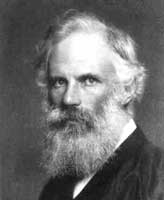 In 1883, (Irish) physicist George Francis Fitzgerald (1851- ) noted that Maxwell's theory of electromagnetic waves indicates that these waves can be generated by PERIODIC VARIATION OF AN ELECTRIC CURRENT. This same year -- despite general scepticism among physicists -- (German) Heinrich Hertz (1857-1894) used an induction coil to generate and
detect radio waves, as Maxwell and Fitzgerald had predicted.
In 1883, (Irish) physicist George Francis Fitzgerald (1851- ) noted that Maxwell's theory of electromagnetic waves indicates that these waves can be generated by PERIODIC VARIATION OF AN ELECTRIC CURRENT. This same year -- despite general scepticism among physicists -- (German) Heinrich Hertz (1857-1894) used an induction coil to generate and
detect radio waves, as Maxwell and Fitzgerald had predicted.
In 1902, using antenna of his own design, (Italian) Gugliermo Marconi (1874-1937)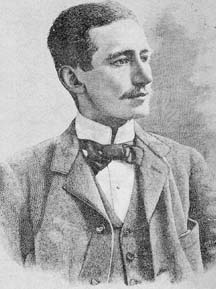 transmitted radio signals across the Atlantic Ocean, from Cornwall in Britain, to Newfoundland in Canada. The Electronic Industrial Revolution was about to begin.
transmitted radio signals across the Atlantic Ocean, from Cornwall in Britain, to Newfoundland in Canada. The Electronic Industrial Revolution was about to begin.
In 1912, at an International Conference of Mathematics, in Copenhagen, Denmark, the great French mathematician, Henri Poincaré, declared that "Mathematics ... has been arithmetized."
declared that "Mathematics ... has been arithmetized."
In 1920, the first radio station, KDKA in Pittsburgh, PA, began broadcasting -- the Electronic Industrial Revolution had begun.
SUMMARY
(FIRST CRISIS IN FOUNDATIONS OF MATHEMATICS) The FAILURE OF THE SQUARE ROOT OF TWO TO BE A RATIONAL NUMBER EVOKED TWO INCORRECT CRIES OF FAILURE:
- NONSENSE THAT ARITHMETIC CANNOT DESCRIBE ALL OF GEOMETRY, SINCE IT SEEMED TO FAIL WITH DIAGONAL OF A SQUARE.
- NONSENSE THAT "MOTION IS GEOMETRY SET TO TIME", SO THE ABOVE ALLEGED FAILURE OF ARITHMETIC WOULD MEAN FAILURE OF ARITHMETIC TO DESCRIBE MOTION. (This stymied dynamic research which stymied industrial revolutions which continued slavery.)
The creation of THE LIMIT OPERATION IN THE "CALCULUS" SHOWED HOW TO CREATE IRRATIONALS (such as THE SQUARE ROOT OF TWO), ALLOWING ARITHMETIZATION OF GEOMETRY (and seeming to resolve THE FIRST CRISIS IN HE FOUNDATIONS OF MATHEMATICS).
But the criticism of George Berkeley of this "Limit" reasoning set off THE SECOND CRISIS
IN THE FOUNDATIONS OF MATHEMATICS.
Fortunately, many mathematicians -- especially, Augustin Cauchy -- showed how to "make
sense" of this PROCESS -- ENSURING EXISTENCE OF IRRATIONALS. You can PROGRAM THEM AS SURELY AS YOU CAN CALCULATE ON A COMPUTER, so THEIR EXISTENCE IS ENSURED BY THE SAME MEANS AS THE COUNTING OF NUMBERS AND SIMPLE ARITHMETIC.
This provided MATHEMATICS to ENSURE THE MECHANICAL INDUSTRIAL REVOLUTION, THE THERMODYNAMIC
INDUSTRIAL REVOLUTION, THE ELECTRICAL INDUSTRIAL REVOLUTION, and THE ELECTRONIC INDUSTRIAL
REVOLUTION (and now begins the NANO-PHOTONIC INDUSTRIAL REVOLUTION). THIS HAS CREATED OUR
MODERN CIVILIZATION AND ENDED SLAVERY IN INDUSTRIAL COUNTRIES.
 , Canon mathematica.
, Canon mathematica. published table of logarithms of sine, cosine, and tangents (not numbers!), for navigational calculations.
published table of logarithms of sine, cosine, and tangents (not numbers!), for navigational calculations. developed a method for calculating maxima and minima of functions or curves, anticipating the "calculus", later developed by Newton and Leibnitz. (This was to "solve THE SQUAREGATE PUZZLE".)
developed a method for calculating maxima and minima of functions or curves, anticipating the "calculus", later developed by Newton and Leibnitz. (This was to "solve THE SQUAREGATE PUZZLE".) Bonaventura Cavalieri (1598-1647) was an Italian
mathematician and student of Galileo. In 1635, in his Geometria indivisibilibis, he stated "Cavalieri's Principle": if two solids have the same height, and if their cross
sections taken parallel to and at equal distances from their bases are always equal, then the
solids have the same volume. This was a stepping stone towards calculus.
Bonaventura Cavalieri (1598-1647) was an Italian
mathematician and student of Galileo. In 1635, in his Geometria indivisibilibis, he stated "Cavalieri's Principle": if two solids have the same height, and if their cross
sections taken parallel to and at equal distances from their bases are always equal, then the
solids have the same volume. This was a stepping stone towards calculus. , published
Logarithmotechnia, with the famous "Mercator" projection still used on maps today -- a great boon to navigation.
, published
Logarithmotechnia, with the famous "Mercator" projection still used on maps today -- a great boon to navigation. In 1670, (English) Isaac Barrow (1630-1677), published Lectiones geometria, with theorems about drawing tangents to curves, calculating lengths of curves and areas under curves. As Newton's teacher, Barrow gave Newton the tangential clue to the differential calculus and the area under a curve clue to the integral calculus.
In 1670, (English) Isaac Barrow (1630-1677), published Lectiones geometria, with theorems about drawing tangents to curves, calculating lengths of curves and areas under curves. As Newton's teacher, Barrow gave Newton the tangential clue to the differential calculus and the area under a curve clue to the integral calculus. (1643-1712) used Barrow's clues to develop his form of calculus, known as "fluxions".
(1643-1712) used Barrow's clues to develop his form of calculus, known as "fluxions". developed the modern notation for calulus, which Leibinitz developed independently of Newton. In 1684 appeared Leibnitz's first paper on calculus.
developed the modern notation for calulus, which Leibinitz developed independently of Newton. In 1684 appeared Leibnitz's first paper on calculus. In 1734, (Irish) George Berkeley, (1685-1743), Bishop of Cloyne,
In 1734, (Irish) George Berkeley, (1685-1743), Bishop of Cloyne,  published his Mechanica, sive motus scientia analytice, formulating "Newton's Laws" in rotational terms and showing the power of The Laws of Linear and Curvilinear Momentum.
published his Mechanica, sive motus scientia analytice, formulating "Newton's Laws" in rotational terms and showing the power of The Laws of Linear and Curvilinear Momentum. In 1776, (English) James Watt installed two of his steam engines, initially used in mining. This same year, John Wilkinson used a steam engine to activate an efficient blast furnace for iron-making. By the end of the century, there were 24 blast furnaces in England. The Thermodynamic Industrial Revolution
had begun. By 1807, American inventor, Robert Fulton (1765=1815), had built a successful
steamship, The Clermont. Steamships eventually ended need for galley-slaves, chained to oarlocks, to
propel warships and other large ships.
In 1776, (English) James Watt installed two of his steam engines, initially used in mining. This same year, John Wilkinson used a steam engine to activate an efficient blast furnace for iron-making. By the end of the century, there were 24 blast furnaces in England. The Thermodynamic Industrial Revolution
had begun. By 1807, American inventor, Robert Fulton (1765=1815), had built a successful
steamship, The Clermont. Steamships eventually ended need for galley-slaves, chained to oarlocks, to
propel warships and other large ships. In 1788, (French) Joseph Louis Lagrange (1736-1813) published his Mechanique analytique, which used work of Euler and the calculus of variations to present an alternative to Newton's laws of physics. From this point on, enough mathematics became available to "ripen" the Mechanical Industrial Revolution, to further The Thermodynamic Industrial Revolution and to prepare for The Electrical Industrial Revolution.
In 1788, (French) Joseph Louis Lagrange (1736-1813) published his Mechanique analytique, which used work of Euler and the calculus of variations to present an alternative to Newton's laws of physics. From this point on, enough mathematics became available to "ripen" the Mechanical Industrial Revolution, to further The Thermodynamic Industrial Revolution and to prepare for The Electrical Industrial Revolution. (1789-1857), putting "calculus" on a firm foundation, a major step in resolving "The Second Crisis in The Foundations of Mathematics". Cauchy defined irrational numbers such as √2 as an unending sequence of rational numbers, each as simple as "an Egyptian fraction".
(1789-1857), putting "calculus" on a firm foundation, a major step in resolving "The Second Crisis in The Foundations of Mathematics". Cauchy defined irrational numbers such as √2 as an unending sequence of rational numbers, each as simple as "an Egyptian fraction". (German) Karl Friedrich Gauss (1777-1855) is considered to be "the greatest of mathematicians". But in 1833, Gauss collaborated with physicist Wilhelm Weber to develop an improvement on Samuel Morse's electric telegraph. The applied mathematics Gauss developed for this, along with that of George Greene, prepared the way for the great work of Clerk-Maxwell and The Electrical Industrial Revolution.
(German) Karl Friedrich Gauss (1777-1855) is considered to be "the greatest of mathematicians". But in 1833, Gauss collaborated with physicist Wilhelm Weber to develop an improvement on Samuel Morse's electric telegraph. The applied mathematics Gauss developed for this, along with that of George Greene, prepared the way for the great work of Clerk-Maxwell and The Electrical Industrial Revolution. discovered diamagnetism and paramagnetism, and related light to magnetism by discovering that a magnetic field affects polarization of light in crystals. So Faraday proposef that light may be waves of electromagnetism.
discovered diamagnetism and paramagnetism, and related light to magnetism by discovering that a magnetic field affects polarization of light in crystals. So Faraday proposef that light may be waves of electromagnetism. In 1855, (Scot) William Thomson (knighted as Lord Kelvin) developed a theory of transmission of electric signals through submarine cables, and later directed the laying of the Trans-Atlantic Cable System. A big advance towards The Electrical Industrial Revolution.
In 1855, (Scot) William Thomson (knighted as Lord Kelvin) developed a theory of transmission of electric signals through submarine cables, and later directed the laying of the Trans-Atlantic Cable System. A big advance towards The Electrical Industrial Revolution. In 1857, (German) physicist Gustav Rudolph Kirkhoff (1824-1887) discovered that statis electric forces and magnetic forces are related by a constant that turned out to be the speed of light in a vacuum, first indication of a relation between electromagnetics and optics. ("Kirkhoff's Laws" are used to day in electric circuit analysis.)
In 1857, (German) physicist Gustav Rudolph Kirkhoff (1824-1887) discovered that statis electric forces and magnetic forces are related by a constant that turned out to be the speed of light in a vacuum, first indication of a relation between electromagnetics and optics. ("Kirkhoff's Laws" are used to day in electric circuit analysis.) In 1860, (Scot) James Clerk Maxwell (1831-1879) -- independently of work by (German) Ludwig Boltzmann (1844-1906) -- developed study of the statistical properties of molecules in a gas -- a great advance in The Thermnodynamic Industrial Revolution. (Texts today speak of "Maxwell-Boltzmann" statistics. It was shifting from these to "Fermi-Dirac statistics" and "Einstein Bose statistics", which initiated one of the greatest advances in quantum theory.)
In 1860, (Scot) James Clerk Maxwell (1831-1879) -- independently of work by (German) Ludwig Boltzmann (1844-1906) -- developed study of the statistical properties of molecules in a gas -- a great advance in The Thermnodynamic Industrial Revolution. (Texts today speak of "Maxwell-Boltzmann" statistics. It was shifting from these to "Fermi-Dirac statistics" and "Einstein Bose statistics", which initiated one of the greatest advances in quantum theory.) put "calculus" on its present firm "arithmetical" foundation.
put "calculus" on its present firm "arithmetical" foundation. lighted New York City -- The Electrical Industrial Revolution had begun.
lighted New York City -- The Electrical Industrial Revolution had begun. In 1883, (Irish) physicist George Francis Fitzgerald (1851- ) noted that Maxwell's theory of electromagnetic waves indicates that these waves can be generated by PERIODIC VARIATION OF AN ELECTRIC CURRENT. This same year -- despite general scepticism among physicists -- (German) Heinrich Hertz (1857-1894) used an induction coil to generate and
detect radio waves, as Maxwell and Fitzgerald had predicted.
In 1883, (Irish) physicist George Francis Fitzgerald (1851- ) noted that Maxwell's theory of electromagnetic waves indicates that these waves can be generated by PERIODIC VARIATION OF AN ELECTRIC CURRENT. This same year -- despite general scepticism among physicists -- (German) Heinrich Hertz (1857-1894) used an induction coil to generate and
detect radio waves, as Maxwell and Fitzgerald had predicted. transmitted radio signals across the Atlantic Ocean, from Cornwall in Britain, to Newfoundland in Canada. The Electronic Industrial Revolution was about to begin.
transmitted radio signals across the Atlantic Ocean, from Cornwall in Britain, to Newfoundland in Canada. The Electronic Industrial Revolution was about to begin. declared that "Mathematics ... has been arithmetized."
declared that "Mathematics ... has been arithmetized."